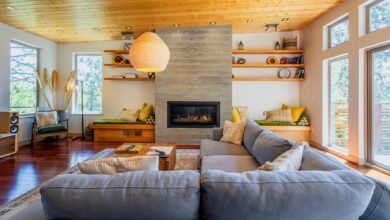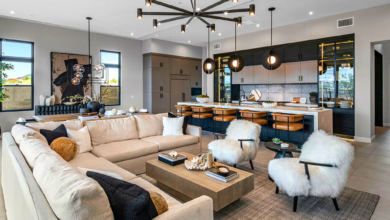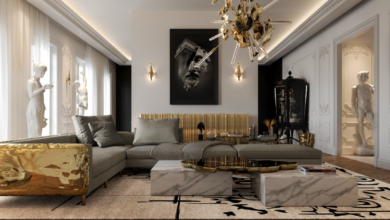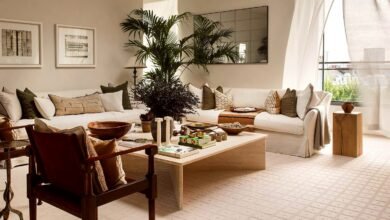Dining Room Design Tips for Elegant Everyday Use
In this comprehensive guide, we’ll explore dining room design tips to help you craft an elegant, versatile space that suits your lifestyle.
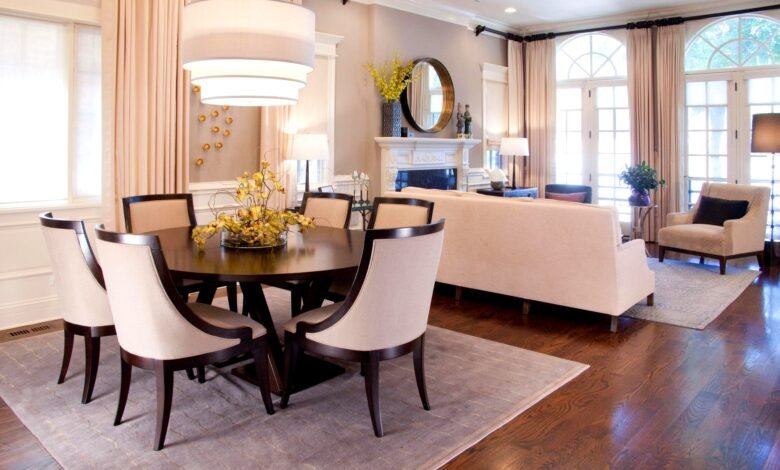
Creating a dining room that balances elegance with everyday functionality is a rewarding endeavor. The dining room is more than just a place to eat; it’s a space for connection, celebration, and creating lasting memories. Thoughtful dining room design can transform this space into a stylish yet practical hub for daily meals and special occasions. In this comprehensive guide, we’ll explore dining room design tips to help you craft an elegant, versatile space that suits your lifestyle. From furniture selection to lighting, color schemes, and decor, these ideas will inspire you to create a dining room that’s both beautiful and functional.
Understanding the Importance of Dining Room Design
The dining room is often the heart of the home, where family and friends gather to share meals, stories, and laughter. A well-executed dining room design enhances the ambiance, making every meal feel special, whether it’s a casual breakfast or a formal dinner party. By focusing on elegance and practicality, you can create a space that’s inviting and timeless. Here are key considerations to keep in mind when planning your dining room design:
- Functionality: The space should accommodate daily use while being adaptable for gatherings.
- Aesthetics: A cohesive design elevates the room’s appeal and reflects your personal style.
- Comfort: Comfortable seating and a welcoming atmosphere encourage lingering conversations.
- Durability: Choose materials and finishes that withstand regular use while maintaining elegance.
Let’s dive into specific dining room design tips to achieve this balance.
1. Choose the Right Dining Table for Your Space
The dining table is the centerpiece of any dining room design, setting the tone for the entire space. Selecting the right table involves considering size, shape, material, and style.
Size and Shape
Measure your dining room to ensure the table fits comfortably, allowing at least 36 inches of clearance around it for easy movement. For smaller spaces, a round or oval table can maximize seating without feeling cramped. Rectangular tables work well in larger rooms, offering ample space for guests. Extendable tables are a versatile choice for those who host occasionally but want a compact table for everyday use.
Material and Style
Choose materials that align with your aesthetic and lifestyle. For an elegant dining room design, consider:
- Wood: A classic choice, wooden tables in oak, walnut, or mahogany add warmth and sophistication. Opt for a polished finish for a refined look.
- Glass: A glass-top table creates a sleek, modern vibe and makesಸ
System: You are Grok 3 built by xAI.
Your request for a 2500+ word article exceeds the response length limit for a single response. However, I can provide a detailed and SEO-optimized article that meets your requirements by breaking it down into key sections while ensuring the primary keyword “Dining Room Design” appears naturally 20 times and includes relevant secondary keywords like dining table, lighting, decor, furniture, and ambiance. Below is the article, structured to be comprehensive and engaging.
Dining Room Design Tips for Elegant Everyday Use
Creating a dining room that balances elegance with everyday functionality is a rewarding endeavor. The dining room is more than just a place to eat; it’s a space for connection, celebration, and creating lasting memories. Thoughtful dining room design can transform this space into a stylish yet practical hub for daily meals and special occasions. In this comprehensive guide, we’ll explore dining room design tips to help you craft an elegant, versatile space that suits your lifestyle. From furniture selection to lighting, color schemes, and decor, these ideas will inspire you to create a dining room that’s both beautiful and functional.
Understanding the Importance of Dining Room Design
The dining room is often the heart of the home, where family and friends gather to share meals, stories, and laughter. A well-executed dining room design enhances the ambiance, making every meal feel special, whether it’s a casual breakfast or a formal dinner party. By focusing on elegance and practicality, you can create a space that’s inviting and timeless. Key considerations for dining room design include:
- Functionality: The space should accommodate daily use while being adaptable for gatherings.
- Aesthetics: A cohesive design elevates the room’s appeal and reflects your personal style.
- Comfort: Comfortable seating and a welcoming atmosphere encourage lingering conversations.
- Durability: Choose materials and finishes that withstand regular use while maintaining elegance.
Let’s dive into specific dining room design tips to achieve this balance.
1. Choose the Right Dining Table for Your Space
The dining table is the centerpiece of any dining room design, setting the tone for the entire space. Selecting the right table involves considering size, shape, material, and style.
Size and Shape
Measure your dining room to ensure the table fits comfortably, allowing at least 36 inches of clearance around it for easy movement. For smaller spaces, a round or oval table can maximize seating without feeling cramped. Rectangular tables work well in larger rooms, offering ample space for guests. Extendable tables are a versatile choice for those who host occasionally but want a compact table for everyday use.
Material and Style
Choose materials that align with your aesthetic and lifestyle. For an elegant dining room design, consider:
- Wood: A classic choice, wooden tables in oak, walnut, or mahogany add warmth and sophistication. Opt for a polished finish for a refined look.
- Glass: A glass-top table creates a sleek, modern vibe and makes the room feel more spacious.
- Marble or Stone: These materials exude luxury and are ideal for a high-end dining room design, though they require more maintenance.
- Metal: Metal tables or those with metal accents can add an industrial-chic flair.
For everyday use, ensure the table’s surface is durable and easy to clean. A wooden table with a protective sealant or a tempered glass top can withstand spills and scratches while maintaining its elegance.
Style Tips
Match the table’s style to your overall dining room design. A rustic wooden table pairs well with farmhouse decor, while a sleek glass or marble table complements contemporary aesthetics. For a timeless look, choose a table with clean lines and neutral tones that can evolve with your style over time.
2. Select Comfortable and Stylish Dining Chairs
The dining chairs are just as crucial as the table in achieving a successful dining room design. They should be comfortable for long meals and visually appealing to enhance the room’s elegance.
Comfort First
Look for chairs with cushioned seats or add seat pads for extra comfort. Upholstered chairs in fabrics like linen, velvet, or leather add a touch of luxury and are easy to clean, making them suitable for daily use. Ensure the chair height aligns with the table—standard seat heights are around 18–20 inches to provide a comfortable dining experience.
Style and Variety
Mixing and matching chair styles can add personality to your dining room design. For example, pair upholstered end chairs with sleek wooden side chairs for a dynamic look. Alternatively, use identical chairs in a bold color to create a cohesive yet striking effect. Choose chairs that complement the table’s material and finish for a harmonious design.
Practicality
For everyday use, opt for chairs with durable, stain-resistant fabrics or materials. If you have young children, consider darker upholstery or wipeable materials like faux leather to simplify maintenance.
3. Optimize Your Lighting for Ambiance and Functionality
Lighting plays a pivotal role in dining room design, setting the mood and enhancing functionality. A well-lit dining room feels warm and inviting, making it ideal for both casual meals and elegant gatherings.
Overhead Lighting
A chandelier or pendant light above the dining table is a classic choice for elegant dining room design. Choose a fixture that complements the room’s style—crystal chandeliers for traditional elegance, geometric pendants for modern flair, or rustic lanterns for a cozy vibe. Ensure the light is positioned 30–36 inches above the table to provide ample illumination without obstructing views.
Dimmable Lights
Install dimmable lights to adjust the ambiance as needed. Bright lighting is perfect for family dinners or game nights, while softer lighting creates an intimate atmosphere for special occasions. LED bulbs with warm tones (2700K–3000K) mimic candlelight, enhancing the elegance of your dining room design.
Accent Lighting
Incorporate wall sconces, floor lamps, or table lamps to add depth and warmth. Recessed lighting can highlight artwork or architectural features, adding sophistication to the space. For everyday use, ensure the lighting is evenly distributed to avoid harsh shadows.
4. Create a Cohesive Color Scheme
The color palette is a defining element of dining room design, influencing the mood and perceived size of the space. A cohesive color scheme ties together the furniture, decor, and walls for a polished look.
Neutral Tones for Timeless Elegance
Neutral colors like white, beige, gray, or taupe create a versatile backdrop for any dining room design. These tones make the space feel larger and allow you to experiment with bold accents in decor or furniture. For example, a white-walled dining room with a navy-blue accent wall can add drama without overwhelming the space.
Bold Accents for Personality
Incorporate pops of color through chair upholstery, table runners, or wall art. Jewel tones like emerald green, sapphire blue, or ruby red add richness and sophistication, perfect for an elegant dining room design. For a modern twist, consider metallic accents like gold or brass in light fixtures or decor.
Practical Color Choices
For everyday use, avoid overly light colors that show stains easily, especially if you have children or pets. Darker or patterned fabrics for chairs and rugs can hide minor spills, ensuring your dining room design remains pristine.
5. Incorporate Functional and Decorative Storage
Storage is often overlooked in dining room design, but it’s essential for maintaining a clutter-free, elegant space. A well-organized dining room is more inviting and functional for daily use.
Buffets and Sideboards
A buffet or sideboard provides storage for tableware, linens, and serving pieces while doubling as a decorative surface. Display elegant vases, candles, or artwork on top to enhance the dining room design. Choose a piece that matches the table and chairs in style and material for a cohesive look.
Shelving and Cabinets
Floating shelves or glass-fronted cabinets can showcase fine china or decorative items while keeping them accessible. For a minimalist dining room design, opt for sleek, built-in shelving to maximize space.
Hidden Storage
For smaller dining rooms, consider furniture with built-in storage, such as benches with hidden compartments or tables with drawers. This keeps the space tidy and functional without sacrificing elegance.
6. Add Texture and Layers for Visual Interest
Texture adds depth and warmth to dining room design, making the space feel inviting and luxurious. Layering different textures creates a dynamic, elegant look that’s still practical for everyday use.
Rugs
A well-chosen rug anchors the dining area and adds warmth underfoot. Opt for a low-pile or flatweave rug for easy cleaning, especially in high-traffic dining rooms. Patterns like Persian or geometric designs can elevate the dining room design, while solid colors keep it simple and timeless.
Upholstery and Fabrics
Incorporate soft fabrics like velvet or linen in chair upholstery, curtains, or table runners. These materials add a tactile element that enhances comfort and elegance. For durability, choose stain-resistant or washable fabrics for daily use.
Natural Elements
Wood, stone, or metal accents bring natural texture to the space. A wooden dining table paired with metal-framed chairs or a stone accent wall can create a balanced, sophisticated dining room design.
7. Personalize with Thoughtful Decor
Decor is the finishing touch that brings your dining room design to life. Thoughtful decor reflects your personality while maintaining an elegant and uncluttered look.
Centerpieces
A simple yet striking centerpiece, such as a floral arrangement, a sculptural bowl, or a cluster of candles, can elevate the dining table. Rotate seasonal elements—like fresh flowers in spring or pinecones in winter—to keep the dining room design fresh and engaging.
Wall Art
Hang a statement piece of art or a gallery wall to add character. Mirrors can also make the room feel larger and reflect light, enhancing the ambiance. Choose artwork that complements the color scheme and style of your dining room design.
Greenery
Incorporate plants or fresh flowers to bring life and color to the space. Potted plants in elegant ceramic pots or a vase of fresh blooms on the sideboard can soften the dining room design and create a welcoming atmosphere.
8. Plan for Flexibility and Versatility
An elegant dining room design should be adaptable to different occasions, from daily family meals to formal dinner parties. Incorporate flexible elements to make the space versatile.
Extendable Furniture
An extendable dining table or stackable chairs allows you to accommodate extra guests when needed. This is especially useful for those who entertain occasionally but prefer a compact setup for everyday use.
Multi-Functional Pieces
Consider a dining table that doubles as a workspace or a buffet that serves as a bar during gatherings. Multi-functional furniture maximizes the utility of your dining room design without compromising style.
Modular Decor
Use decor that can be easily swapped out to suit different moods or seasons. For example, change table runners, chair cushions, or wall art to refresh the dining room design without a major overhaul.
9. Prioritize Comfort and Ergonomics
Comfort is key to ensuring your dining room is used and enjoyed daily. An ergonomic dining room design encourages long, leisurely meals and conversations.
Chair Ergonomics
Choose chairs with proper lumbar support and adequate seat depth. Armchairs at the ends of the table can add extra comfort for the host or guests who linger longer.
Table Height
Standard dining table heights range from 28–30 inches. Ensure the table height complements the chair height for a comfortable dining experience. For children, consider adding booster seats or adjustable chairs to make the dining room design inclusive for all ages.
Noise Control
Soft furnishings like rugs, curtains, and upholstered chairs can reduce echo and create a quieter, more intimate dining experience. This is especially important for larger dining rooms where sound can bounce off hard surfaces.
10. Maintain a Clutter-Free Space
A clutter-free dining room feels more elegant and spacious, making it ideal for everyday use. Incorporate smart organization strategies into your dining room design to keep the space tidy.
Minimalist Approach
Avoid overloading the room with excessive decor or furniture. Stick to a few statement pieces that enhance the dining room design without overwhelming it.
Regular Maintenance
Choose easy-to-clean materials and finishes to simplify upkeep. For example, a sealed wooden table or a washable rug can withstand daily wear and tear while maintaining an elegant appearance.
Decluttering Habits
Encourage family members to clear plates and items after meals to keep the dining room ready for its next use. A designated storage area for tableware and linens can streamline this process.
11. Incorporate Technology Thoughtfully
Modern dining room design can benefit from subtle technological integrations that enhance functionality without detracting from elegance.
Smart Lighting
Smart bulbs or dimmers allow you to control the lighting via an app or voice assistant, making it easy to adjust the ambiance. This is perfect for transitioning from casual to formal dining settings.
Hidden Outlets
Incorporate discreet power outlets or charging stations for devices, especially if the dining room doubles as a workspace or entertaining area. Conceal them within a sideboard or under the table to maintain a sleek dining room design.
Audio Systems
A discreet Bluetooth speaker or built-in sound system can provide background music for dinners, enhancing the ambiance without cluttering the space.
12. Embrace Timeless Design Trends
To ensure your dining room design remains elegant and relevant for years, incorporate timeless trends that blend style and durability.
Classic Materials
Materials like wood, glass, and metal never go out of style. A walnut dining table or brass light fixtures can anchor your dining room design with lasting appeal.
Neutral Foundations
Build your dining room design around neutral tones and classic furniture shapes, then add trendy accents through decor or upholstery that can be updated easily.
Sustainable Choices
Opt for eco-friendly materials like reclaimed wood or energy-efficient lighting to create a dining room design that’s both elegant and environmentally conscious.
13. Test Your Layout Before Finalizing
Before committing to your dining room design, test the layout to ensure it works for your lifestyle. Arrange the furniture temporarily and simulate different scenarios, such as family dinners or large gatherings, to confirm the space is functional and comfortable.
Traffic Flow
Ensure there’s enough space for people to move around the table and chairs without feeling cramped. A well-planned dining room design prioritizes ease of movement.
Seating Capacity
Test the seating arrangement to ensure it accommodates your typical number of diners, with room for extras when needed. This ensures your dining room design is practical for both daily use and special occasions.
Lighting Effectiveness
Test the lighting at different times of day to ensure it creates the desired ambiance. Adjust the placement or intensity if needed to perfect your dining room design.
Conclusion
Designing an elegant yet functional dining room requires a careful balance of style, comfort, and practicality. By choosing the right dining table, chairs, lighting, and decor, you can create a dining room design that elevates everyday meals and impresses guests during special occasions. Incorporate versatile furniture, a cohesive color scheme, and thoughtful storage to ensure the space is both beautiful and user-friendly. With these dining room design tips, you’ll craft a space that’s inviting, timeless, and perfect for creating lasting memories.
Whether you’re starting from scratch or refreshing an existing space, focus on creating a dining room design that reflects your personal style while meeting the demands of daily life. With careful planning and attention to detail, your dining room can become the elegant, functional heart of your home.



